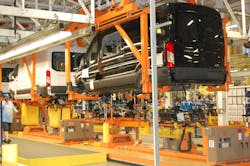The latest forecast from the National Automobile Dealers Association (NADA) projects that sales/leases of new cars and light trucks should set an “all-time record” in 2016, in the words of Steven Szakaly, the group’s chief economist – surpassing 17.7 million units, which is a 2% increase over 2015’s record-setting numbers.
“It will be the seventh consecutive year of auto sales growth [and] setting back-to-back records,” Szakaly said in a statement ahead of the opening of the North American International Auto Show (NAIAS) in Detroit this week.
“We are living peak auto sales right now, and we will see one more year of that growth in 2016,” he explained. “But only because of rising incentives that will keep consumers coming into showrooms. The real worry now is whether we’re starting to pull sales ahead from future years.”
In 2015, a record 17.4 million new light vehicles were retailed, up 5.8% from 2014, according to WardsAuto, with the average transaction price of a new car and light truck reaching $33,269 last year, according to NADA.
Those numbers dovetail with data points issued by J.D. Power and LMC Automotive late last year, which indicated new light-vehicle sales in December turned in their strongest performance of any month since 2005, putting 2015 on t“With continued record transaction prices, consumers are on pace to spend more than $44 billion on new vehicles in December and $437 billion on new vehicles in 2015, both record levels,” noted John Humphrey, senior VP of the global automotive practice at J.D. Power, in a statement.
“We now have greater confidence that record sales in 2015 will lead to yet another volume record in 2016,” added Jeff Schuster, senior VP of forecasting at LMC Automotive. “The year-over-year growth rate is projected to be one-third of the growth experienced in 2015, but total and retail light-vehicle sales are at a 2% increase in 2016, keeping the expansion going.”
NADA’s Szakaly stressed that, in the battle for market share, automakers are expected to increase incentives in 2016 as a way to sustain the use of increased manufacturing capacity and to offset the effects of a slowing global economy, especially in emerging markets.
“If we were looking at a market with stable global growth and no increases in manufacturing, auto sales might actually fall in 2016,” he pointed out.
“But we have a situation where plants have been built, demand is slowing, and the U.S. market remains the most profitable in the world,” Szakaly said. “Growth in places like Mexico will offer some temporary reprieve, but it won’t be sufficient to offset falling demand from Brazil, South Africa and other emerging markets. This means incentives will rise to stoke demand.”
He emphasized, however, that this “sustained sales momentum” expected for 2016 is dependent on several factors:
- Expectations that auto financing rates will remain competitive, with interest rates rising modestly – by less than one percentage point – by the end of 2016;
- That wages will grow about 2.5% this year;
- That the economy will add more than 2 million net new jobs in 2016.
About the Author
Sean Kilcarr
Editor in Chief
Sean Kilcarr is a former longtime FleetOwner senior editor who wrote for the publication from 2000 to 2018. He served as editor-in-chief from 2017 to 2018.

